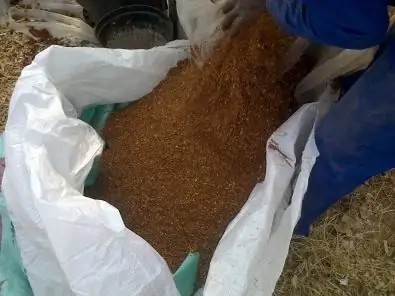Tobacco dust is a natural and highly effective insecticide that has been used successfully against various insect pests. Slugs, bedbugs, flies, larvae of various insects that harm agricultural plantings are afraid of tobacco.

Tobacco dust, the use of which is quite effective, is also used in crop production, beekeeping and horticulture. It is considered an excellent fertilizer that increases microbiological activity and soil nutrition. Outwardly, it is dust that has a brown tint.
Properties of tobacco dust
It is very important that the drug is a biologically pure material. It does not contain harmful microorganisms and is completely safe for any application. There are no weed seeds in tobacco dust, and with long-term use, the soil does not accumulate any harmful substances. Due to the content of phosphorus, nitrogen, potassium - mineralized types of trace elements - tobacco dust improves the nutrition of absolutely all types of plants. It also enhances the agrochemical and physico-biological properties of the soil as a whole.
Where usedtobacco dust
As mentioned above, the list of applications is quite wide.
- The main task of the drug is the fertilizer of absolutely any garden, agricultural and greenhouse crops without prior preparation.
- It is common to use tobacco dust together with mineral fertilizers during soil plowing in combination of 20-40 tons per 1 ha.
- Used when sowing winter and spring crops in combination of 4 tons per 1 ha.
- Ornamental crops and fruit and berry plantations are planted after fertilizing with tobacco dust in the amount of up to five kilograms per planting hole.
- Dust is used in lawn preparation. You can spray up to three kilograms of the drug on the already prepared land, walk carefully with a rake and water it. After this procedure, a general seeding is carried out.
- It is recommended to fertilize potted plants and flowers with the preparation. Proportions are taken 1:1:1 with soil and clean sand.
- Fields with crop rotation are fertilized with the drug every three years.
Tobacco dust from pests

It is good to fight insects that spoil plantings with tobacco infusion. To prepare it, you should take 500 g of the drug, pour it into a container, pour ten liters of water and insist for two days. After that, everything is filtered through cheesecloth so that the sprayer does not clog. You can supplement the mixture with a soapy solution from laundry soap (50 g). The soap will help the solution adhere to the leaves of the plants. There is an infusion against pests such as:
- aphid;
- thrips;
- copper;
- sawfly larva;
- caterpillars.
You can pollinate plantings with tobacco dust. To do this, tobacco dust and slaked lime (or sunflower ash) are taken, mixed in a one-to-one ratio and scattered over the desired area. Thus destroyed:
-

tobacco dust from pests slugs (up to 30 g per meter);
- fleas (three times a month);
- other pests (three times a week);
- onion flies (10 g per meter, once in the summer months).
You can fumigate greenhouses by burning a mixture on a baking sheet - 500 g per meter. The method kills aphids, thrips, whiteflies. Fruit and berry bushes and trees are fumigated against suckers and aphids after flowering during the winging period of insects. Combustible garbage and chips are placed in a bucket, and when the fire breaks out, they add up to a kilogram of tobacco dust. Fumigated for half an hour in calm weather. It should be clarified that smoke does not cause any harm to bees.






